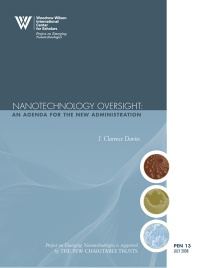Nanotech: A Regulatory Blueprint for the Next Administration
Former EPA Official Highlights Shortcomings of Current Federal Oversight
 Washington, DC — Nanotechnology will significantly change virtually every facet of the way we live. The next president has the opportunity to shape these changes and to ensure that nanotechnology’s benefits will be maximized and its risks identified and controlled. A new report by former EPA official J. Clarence (Terry) Davies lays out a clear roadmap for the next presidential administration and describes the immediate and longer term steps necessary to deal with the current shortcomings of nanotechnology oversight.
Washington, DC — Nanotechnology will significantly change virtually every facet of the way we live. The next president has the opportunity to shape these changes and to ensure that nanotechnology’s benefits will be maximized and its risks identified and controlled. A new report by former EPA official J. Clarence (Terry) Davies lays out a clear roadmap for the next presidential administration and describes the immediate and longer term steps necessary to deal with the current shortcomings of nanotechnology oversight.
“The future of the technology is in the hands of the incoming administration. The shape of the future will depend significantly on what the new government does,” says Davies, whose report, Nanotechnology Oversight: An Agenda for the Next Administration, was released today.
In the report Davies calls for the White House and federal agency policymakers to maximize the use of existing laws to improve nanotechnology oversight. Such measures include defining nanomaterials as “new” substances under federal toxics and food laws, thereby enabling the Environmental Protection Agency (EPA) and the Food and Drug Administration (FDA) to consider the novel qualities and effects of nanomaterials. Davies also calls for federal pesticide and workplace safety laws to be used to protect against potential adverse impacts of nanomaterials.
Immediate policy changes, however, need to be followed by longer-term changes to existing oversight laws. For example, two major high-exposure applications of nanotechnology – cosmetics and dietary supplements – are essentially unregulated. The Federal Food, Drug and Cosmetic Act needs to be amended to deal with these applications. Other laws important to nanotechnology, such as the Toxic Substances Control Act and the Consumer Product Safety Act, also need radical revision, Davies says.
 Without increased funding and staffing for relevant agencies many of the actions called for in the report will not be possible.
Without increased funding and staffing for relevant agencies many of the actions called for in the report will not be possible.
“In order to ensure the safe development of this rapidly advancing technology, which is projected will enable 15 percent of globally manufactured goods worth $2.6 trillion by 2014, there needs to be an increase in nanotechnology risk research monies in the fiscal year 2009 budget to $100 million and in FY 2010 to $150 million,” says David Rejeski, the director of the Project on Emerging Nanotechnologies.
The report highlights the importance of creating sensible nanotechnology oversight policies that will help ensure the safe and sustainable application of nanotechnologies to climate change, food security, water purification, health care, and other pressing global problems.
“Potential risks of nanoscale materials have already been identified, and for the world to realize the benefits of this technology, the next administration must act swiftly and carefully,” Rejeski says. “This will be a challenge, but one that could have limitless opportunities to improve the world in the 21st century.”
July 23, 2008
Summary
Nanotechnology will significantly change virtually every facet of the way we live. The next president has the opportunity to shape these changes and to ensure that nanotechnology’s benefits will be maximized and its risks identified and controlled. A new report by former EPA official J. Clarence (Terry) Davies lays out a clear roadmap for the next presidential administration and describes the immediate and longer term steps necessary to deal with the current shortcomings of nanotechnology oversight.



